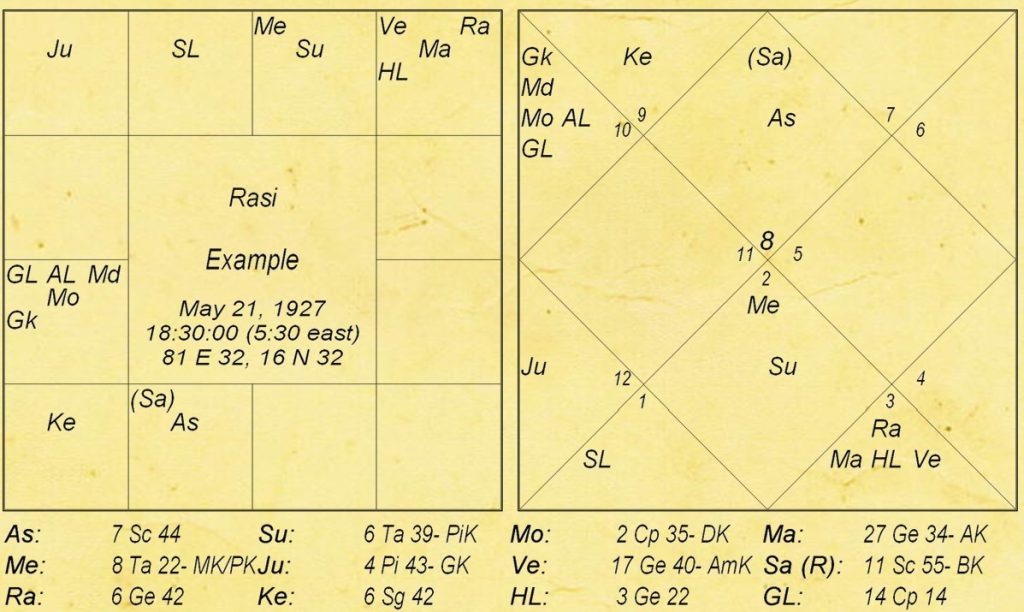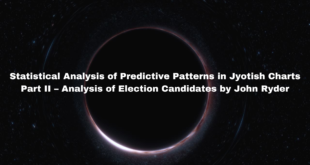Related Articles
The relevant Jaimini aphorism of Trikona Dasa is:
मातृ पितृ धर्म प्राण्यादि स्त्रिकोणे
mātṛ pitṛ dharma prāṇyādi strikoṇe
which simply states that Trikona Dasa begins from Janma Lagna or the 5th house or the 9th house whichever is stronger. There is no divided opinion among the commentators with regard to the beginning of Trikona Dasa.
Though pitru and matru, by Katapayadi pneumonics, connote birth ascendant (Janma Lagna) and the 5th house respectively, the word Dharma, by the same rule, does not give the numerical value of 9. Some commentators are therefore inclined to interpolate the word Dhama in the place of Dharma to convey the meaning of the 9th house.
To judge the strengths of the above mentioned three houses, please see Studies in Jaimini Astrology of Dr B.V RAMAN.
Method 1:
Succession of dasas:
Some commentators opine that by the very name Trikona, Dasas run in the order 1, 5, 9 etc. Profound erudites, Dr. RAMAN, Dwivedi and Achutanarda Jha, while accepting this view, gave an example of a dual sign to begin with. It appears obvious that they are averse to apply the above mentioned order 1, 5, 9 in the case of cardinal and fixed signs also, since the order is contrary to the principles enunciated by the aphorisms (2, 4, 8, 9, and 10).
After noting down the 12 Dasa signs from the commencing dasa sign, preferably a dual sign, (if decided as the strongest of the three), Dasa periods which mean the number of years of each Dasa sign should be found out. The aphorisms immediately previous to Trikona aphorism are
मातृ धर्मयोः सामान्यं विपरीतं ओजकूतयोः
यथा सामान्यं युग्मे
mātṛ dharmayoḥ sāmānyaṁ viparītaṁ ojakūtayoḥ
yathā sāmānyaṁ yugme
The aphorisms mean that the count from Leo and Aquarius is reverse and the count from Taurus and Scorpio is direct. These two exceptions are deduced from the aphorism न क्वचित् (na kvacit). The general principles in respect of dual signs, viz., direct for odd signs and reverse for even signs, stand good. The above exceptions are also known from an obsolete Karika
जन्मकालग्रह स्थित्या गोचरस्थ ग्रहैरपि।
विचारितैः प्रवक्तव्यं स्यात् त्रिकोण दशाफलम्॥
janmakālagraha sthityā gocarastha grahairapi |
vicāritaiḥ pravaktavyaṁ syāt trikoṇa daśāphalam ||
As a result based on another obsolete Karika,
मेषादि त्रित्रिभिः ज्ञेयं पदमोजपदे क्रमात्।
दशाब्दानयने कार्यं गणना व्युत्क्रमात् समे॥
meṣādi tritribhiḥ jñeyaṁ padamojapade kramāt |
daśābdānayane kāryaṁ gaṇanā vyutkramāt same ||
Neelakanta classified the 12 signs as Vishama Pada (odd triads) and Sama Pada (even triads).
Even triads: Cancer, Leo, Virgo, and Capricorn, Aquarius, Pisces
Odd triads: Aries, Taurus, Gemini, and Libra, Scorpio, Sagittarius.
Dasa periods are to be found out based on the above classification. Judgement of dual lordships of Scorpio and Aquarius is also favoured by Dr Raman and others. Please see Studies in Jaimini Astrology for details.
Method 2:
Commentators, viz., Raghava Bhatta and Nrisimha Suri, dealt Trikona Dasa elaborately for predictive elements and otherwise called it Gochara Dasa which seems apt by its nature of predictive elements as seen from an ancient Karika,
जन्मकालग्रह स्थित्या गोचरस्थ ग्रहैरपि।
विचारितैः प्रवक्तव्यं स्यात् त्रिकोण दशाफलम्॥
janmakālagraha sthityā gocarastha grahairapi |
vicāritaiḥ pravaktavyaṁ syāt trikoṇa daśāphalam ||
Trikona Dasa begins from Janma Lagna (birth ascendant) or the 5th house or the 9th house whichever is stronger.
Succession of Dasas:
- If the commencing Dasa sign is cardinal (Chara), Dasas run regularly in the direct order if that Dasa sign is odd or run regularly in the reverse order if that Dasa sign is even.
- If the commencing Dasa sign is fixed, Dasas run in the order of every 6th, direct, if that Dasa sign is odd, or reverse in the order of every 6th, if that Dasa sign is even.
- If the commencing Dasa sign is dual, Dasas run in the order of 1,5, 9 (लग्न पंचम भाग्यतः lagna paṁcama bhāgyataḥ) direct if that Dasa sign is odd, or reverse in the order of 1, 5, 9 if that Dasa sign is even.
Odd signs: Aries, Gemini, Leo, Libra, Sagittarius, Aquarius.
Even signs: Taurus, Cancer,Virgo, Scorpio, Capricorn, Pisces.
The combined concept of reckoning by odd or even and by cardinal, fixed or dual signs is impregnated in the aphorisms,
प्रथम प्राक् प्रत्यक्त्वम्
द्वितीये रवितः
पृथक् क्रमेण तृतीये चतुष्टयादि
prathama prāk pratyaktvam
dvitīye ravitaḥ
pṛthak krameṇa tṛtīye catuṣṭayādi
This combined concept is called Prakriti Chakra Padakrama.
Dasa Periods:
- Count the number of signs from Dasa sign to its lord, direct if that Dasa sign is odd, or reverse if that Dasa sign is even.
- If the lord of the Dasa sign is exalted, add one year to the above count.
- If the lord of the Dasa sign is debilitated, deduct one year from the count.
- If the lord of the Dasa sign is in the same sign, the Dasa sign gets 12 years.
Raghavabhatta does not favour the consideration of dual lordships of Scorpio and Aquarius for Dasa periods, but recommends it for reckoning the 8th house in the context of longevity determination.
It should be noted that no Dasa sign gets more than 12 years, because of the word Viveka in the aphorism connected with Antardasa calculation, since Viveka meant 144, which when divided by 12 gives 12.
Method 3:
Neelakanta meant a different exposition of reckoning Trikona Dasa. Apropos, he quoted Vridhakarika which is as follows:
लग्नत्रिकोणयोः राशिर्बलवानुक्तहेतुभिः।
तदारभ्योन्नयेत् श्रीमांश्चरपर्यायवद्दशा॥
युग्मराशिभुवां पुंसामोजगृह्णीतसम्मुखम्
ओजराशि भुवां पुम्सां गृह्णीयादोजमेवतु
ओजराशि भुवां स्थ्रीणां युग्मम् गृह्णीत सम्मुखम्
युग्म राशि भुवां स्थ्रीणां युग्ममेव समास्रयेत्
क्रमोत्क्रमाभ्यां गणयेदोज युग्मेषु राशिषु
पदक्रमेण सर्वत्र दशानयन मत्रहि
lagnatrikoṇayoḥ rāśirbalavānuktahetubhiḥ |
tadārabhyonnayet śrīmāṁścaraparyāyavaddaśā ||
yugmarāśibhuvāṁ puṁsāmojagṛhṇītasammukham
ojarāśi bhuvāṁ pumsāṁ gṛhṇīyādojamevatu
ojarāśi bhuvāṁ sthrīṇāṁ yugmam gṛhṇīta sammukham
yugma rāśi bhuvāṁ sthrīṇāṁ yugmameva samāsrayet
kramotkramābhyāṁ gaṇayedoja yugmeṣu rāśiṣu
padakrameṇa sarvatra daśānayana matrahi
The above mentioned Vriddhakarika states that Trikona Dasa begins from birth ascendant or the 5th house or the 9th house, whichever is stronger. Neelakanta meant Chara Paryayavad as the count of Dasa periods by ‘Nadanta samah’, while Raghavabhatta meant it as another variety of Dasa called Chara Paryaya Dasa, different from Trikona Dasa.
Now let us understand from the Karika the reckoning of Trikona Dasa in male and female horoscopes.
Male horoscope: Find the strongest of Janma Lagna, the 5th and 9th houses. If the strongest is an even sign, take its sammukha sign which is odd to begin Trikona Dasa from the sammukha sign. If the strongest is an odd sign take the same odd sign to begin. In both cases, since the beginning Dasa sign is odd, Dasas run in the direct order.
Female horoscope: If the strongest of the birth ascendant (Janma Lagna), the 5th house and the 9th house is odd, take its sammukha sign which is even to begin Trikona Dasa. If the strongest is an even sign, take the same even sign to begin Trikona Dasa. In both the cases, since the commencing Dasa sign is even, Dasas run in the reverse order. Thus it comes to our understanding that Dasas run in the direct order in the case of male horoscope, while dasas run in the reverse order in the case of female horoscope from the commencing sammukha signs. The karika does not specify padakrama order (regular, every 6th and 1st, 5th, 9th) according as cardinal, fixed and dual signs respectively. But this order may have its sanction on the basis of the aphorisms No: 2,4,8,9,10.
Now what are the sammukha signs?
According to an obsolete Karika of Premnidhi Pandit, the 8th of a cardinal sign, the 6th of a fixed sign and the 7th of a dual sign are sammukha signs. If two are facing each other and thus looking at each other, the two are said to be sammukha or abhimukha aspects. Please see Table 1 for signs and sammukha signs according to the Karika.

Neelakanta disagrees with the above design of sammukha signs and opines that Karika is quoted in the context of aspects. But most other commentators, while accepting the sammukha aspects of cardinal and fixed signs, differ in the case of dual signs.
Now see Table 2 of sammukha signs. From table 2, we come to know that a sammukha sign of a dual sign is the 4th counted direct for the odd and reverse for the even.
Let us analyse the given Karika of Trikona Dasa, quoted by Neelakanta. The Karika states that for male horoscopes who have even signs to begin, their sammukha signs which are odd should be taken to reckon with. Taurus is an even sign and its sammukha sign is Libra which is odd. Cancer is an even sign and its sammukha sign is Aquarius which is odd. So far there is no contradiction to the exposition of the above Karika. But for a dual sign, if its 7th is accepted there remains a paradox. That is, if Pisces, the 7th of Virgo is accepted as sammukha sign, it is contrary to the statement because Pisces is not odd but even. Hence the sammukha sign of Virgo should be its 4th Gemini, which is odd, but never the even 7th Pisces, an even sign. Similarly, Pisces is an even sign and Virgo; the 7th cannot be its sammukha sign. Sagittarius, the 4th of Pisces should be the sammukha of Pisces.
For female horoscopes who have odd signs to begin, the sammukha signs which are even should be taken to commence Trikona Dasa. Aries is an odd sign and its sammukha is Scorpio which is even. Leo is an odd sign and its sammukha is Capricorn which is even. So far, correct. But for dual Gemini, Sagittarius the 7th cannot be its sammukha because Sagittarius is odd. Hence the sammukha of Gemini is its 4th Virgo, which is even. Similarly the sammukha of Sagittarius is not Gemini but Pisces.
It may be questioned – the 4th of Virgo is not Gemini but Sagittarius. Hence why not Sagittarius be the sammukha of Virgo? Similarly why cant Gemini be the sammukha of Pisces?
No – sammukhatwam means facing each other. If Sagittarius is the sammukha of Virgo and Pisces is also the sammukha of Sagittarius, how can Sagittarius be facing both Virgo and Pisces? Hence Gemini-Pisces and Virgo-Sagittarius cannot be the pairs of sammukha-signs. Thus it is concluded that Gemini-Virgo and Sagittarius-Pisces are the pairs of sammukha signs as seen from Table 2. Since Adarsa, Abhimukha, Darpana, Sammukha are synonyms, and since the numerical value of Adarsa, used by Jaimini Maharshi in four aphorisms, is four, there is every justification of the 4th being the sammukha of a dual sign. The opinion of the 7th being the sammukha of a dual sign is disproved.
For clarity of understanding, I shall illustrate the three methods of Trikona Dasa with the following chart:
Example: Date of Birth: 21-5-1927 at 6-30 PM
Birth ascendant: Scorpio

The strongest of Lagna, the 5th and the 9th houses, is the 5th Pisces, a dual sign occupied by Jupiter.
Method 1:
Dasas are Pisces, Scorpio, Cancer, Aquarius, Libra, Gemini, Capricorn, Virgo, Taurus, Sagittarius, Leo, Aries.
The numbers of years of the above Dasas are respectively: 12, 7, 6, 8, 8, 11, 2, 4, 1, 3, 3, 2
Method 2:
Dasas are Pisces, Scorpio, Cancer Aquarius, Libra, Gemini, Capricorn, Virgo, Taurus, Sagittarius, Leo, Aries.
The number of years of the above Dasas are respectively : 12, 6, 7, 10, 9, 12, 3, 5, 12, 4, 10, 3
Method 3:
The sammukha sign of Pisces is Sagittarius. Hence Dasas commence from Sagittarius, a dual sign. So Dasas are Sagittarius, Aries, Leo, Capricorn , Taurus, Virgo, Aquarius, Gemini, Libra, Pisces, Cancer, Scorpio.
The number of years of the above Dasas are respectively: 3, 2, 3, 2, 1, 4, 8, 11, 8, 12, 6, 7
Predictive elements of Trikona Dasa need a separate article and hence I conclude for the present.
 Saptarishis Astrology Magazine Into Creating Astrologers
Saptarishis Astrology Magazine Into Creating Astrologers






